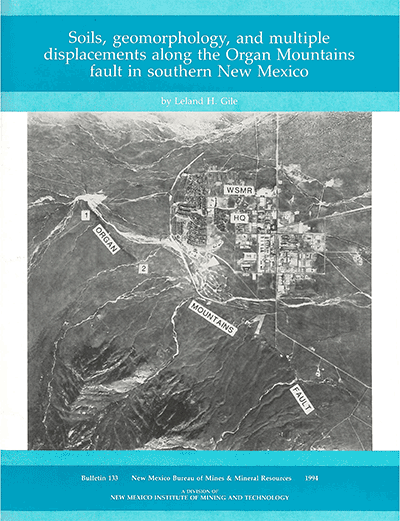
Bulletin 133—Soils, geomorphology, and multiple displacements along the Organ Mountains fault in southern New Mexico
By L. H. Gile, 1994, 91 pp., 25 tables, 60 figs. (including 11 aerial photos), glossary.

The Organ Mountains fault occurs along the eastern side of the Organ and San Andres Mountains in Doña Ana County, NM. The fault is one of the youngest in NM and is of particular local interest and significance because (1) episodes of faulting are accompanied by severe earthquake activity, (2) major centers of population are nearby, and (3) the fault is very close to the headquarters of the White Sands Missile Range (WSMR). This report presents a study of soils, geomorphology, and evidence of both late Holocene and pre-Holocene displacements along the fault.
A previous study along the Organ Mountains fault in southern NM found evidence of a displacement estimated to have taken place about 1,000 years ago. The late Holocene fault scarp associated with the displacement represents one of the youngest if not the youngest fault in NM. In this study, examination of an older scarp adjacent to the late Holocene scarp revealed buried evidence of late Holocene faulting below the base of the older scarp. This evidence consists of displaced sediments and soils of late Pleistocene age, and post-faulting sediments and soils similar to those at the late Holocene scarp. Prominent soils on large parts of the older scarp indicate that, as a general landscape feature, the scarp must date from the Pleistocene.
The discovery of such masking of faults below an ancient scarp indicates that the late Holocene faulting previously reported could be much more extensive than suggested by the downfaulted late Holocene sediments alone. Total displacement of the late middle Pleistocene sediments along the ancient scarp must be more than the minimum of 80–82 ft shown by the present scarp. Below the ancient scarp, late Holocene displacement at the fault plane is estimated to be about 3 ft; if nearby downwarping also reflects late Holocene faulting then the total displacement for the late Holocene would be considerably greater.
Two depositional zones that differ considerably in particle size are characteristic of the late Holocene faulting at both scarps, and are useful criteria that reflect episodes of faulting in these materials. One zone, termed the skeletal zone, is dominated by rock fragments and is emplaced almost immediately after faulting as an erosional response to the downdropped materials below the fault. The fine-earth zone is deposited later by small streams that cross the scarp and by overland flow, and commonly buries the skeletal zone in part. Soils formed in one or both of these two zones constitute major chronological markers for the study of displacement times. Below the base of the ancient scarp, the displaced soil of late Pleistocene age has formed in a fine-earth zone that reflects an episode of faulting older than the late Holocene displacement. Although this soil needs further study, its prominent horizons of clay and carbonate accumulation could indicate, at some locations along the fault, a time of stability and soil formation that would be longer than the current estimate of about 5,000 years for the maximum interval of time between faulting episodes.
$10.00
Buy
Now
Also available as a free download.
Download
| File Name | Size | Last Modified |
|---|---|---|
| B133.pdf | 17.25 MB | 06/09/2015 03:07:59 PM |



